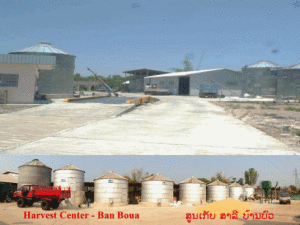 XP Harvest Center
XP Harvest Center
Harvest Centers target one challenge in Laos which is maize (corn) production, as it needs to dry very soon after harvesting in order to prevent substantial post-harvest loss (i.e., mold-induced spoilage insects, etc).
To avoid spoilage losses, farmers are forced to sell wet maize at low harvest prices to “truck vendors” parked along the road which haul the wet maize to Thailand or Vietnam where it is dried, processed and utilized as feed for animal production. This means money that could help Laos grow is leaving the country and Laotian farmers are be shorted on the true value of what they are producing.
XP Trading goal of establishing “Harvest Centers” in targeted regions is an opportunity to provide community-based, possibly coop owned, locations where smallholder farmers can bring their maize to sell, or to have it dried and sell dried maize on their own, or to “trade” their maize for animal feed (i.e., ground corn rations enhanced with protein, mineral and vitamin mixes to make complete feeds). This can be applied to other commodities as well, such as, rice, soybeans, and cassava.
These harvest centers are unique in that they have consisted of a combination of used U.S., China-sourced and locally manufactured grain handling, drying and storage equipment. Some of the equipment has been re-engineered including Laos-built grain augers, cleaners, silos, burners, and feed milling equipment.
XP Trading has already established five Harvest Centers in Central and Northern Laos. Three of which are break even or better income centers. These centers have the capacity to serve more than 3,000 smallholder maize producers. This would and has increased with the processing of other grains. In at least one location the simple process of drying the maize, which stopped the post harvest loss and increased the selling price, gave local smallholders who were making $600 to $800 a year and increase to $1600 to $1800 GDP which puts them above the Lao desired goal.
In Laos, electricity supply is reliable thanks to hydropower and rural electrification, which has seen substantial progress in recent years due to LAO PDR initiatives. Heat for artificial drying of maize (and other crops) can be generated using wood, rice husk, maize cobs and other biomass in specially XP designed burners equipped with heat exchangers to avoid exhaust air from contaminating the crop to be dried.
Silo dryers in these Harvest Centers have initially been equipped with wood-burning heat exchangers and 7.5 kW centrifugal fans imported from China at a cost of $7,500 per fan-burner unit. A Lao re-reengineered complete fan-burner unit with a 2.2 kW Chinese axial flow fan and biomass burner has been developed and is being used. The estimated sales price of the XP brand Lao-made fan-burner unit is $2,500.
A XP designed Lao built silo dryer has recently been built at XP’s facility. When combined with a XP Lao built fan-burner unit, a drying floor, a XP Lao built loading and unloading auger, and a shed-like roof, this XP Lao-made silo dryer unit can dry 5 MT of maize from 25% to 13% moisture content within 18 hours.
A partner of XP Trading, Agriasie an organic farm is using this Lao-built silo dryer, it has been equipped with a drying air recirculation system. In addition to drying wet maize, it is also being used to dehydrate fruits and botanicals. This extends the utilization of this system to multiple crops and harvest cycles per year, which makes it an attractive investment for an entrepreneurial smallholder farmer that produces multiple crops. Again creating more job opportunities of the rural people of Laos.
Smallholder farmers at numerous locations have clearly expressed their preference for delivering their wet maize to the local Harvest Center instead of the road truck vendor heading across the Mekong River to Thailand or into Vietnam.
The additional opportunity to “buy” shares individually or as a coop in a Harvest Center, or to purchase feed to “contract feed” pigs or poultry (e.g., broilers) is an appealing value-added income producing opportunity for these smallholder farmers. The potential return on cash crop maize converted into pork or broiler protein is estimated to be three to five times what could be derived from just selling the maize or $15,000 per year. Net profit for smallholder farmers will of course depend on their costs of maize and animal production. Feed milling capacity at a Harvest Center is currently sized to require maize from 5,000 smallholder producers. Feed manufacturing could also provide opportunity for increasing the sagging soybeans production to make complete feeds. Lao does not currently allow maize to be imported, however, soybeans can be imported.
XP Harvest Centers are just the first phase in fully linked plan for impacting the poor villages of Laos
